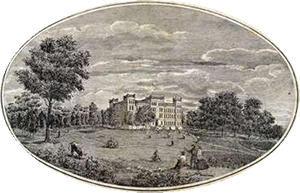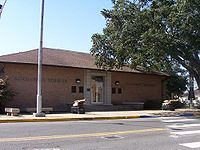
Louisiana State Seminary of Learning & Military Academy
Encyclopedia

Louisiana State University
Louisiana State University and Agricultural and Mechanical College, most often referred to as Louisiana State University, or LSU, is a public coeducational university located in Baton Rouge, Louisiana. The University was founded in 1853 in what is now known as Pineville, Louisiana, under the name...
(LSU).
The original legislation creating the Seminary of Learning of the State of Louisiana (l'Universite' de l'Etat de la Louisiane) was passed by the Louisiana General Assembly in 1853. This was to be a state institution of higher education.
In November 1859, the institution's main building was completed near Pineville, Louisiana
Pineville, Louisiana
Pineville is a city in Rapides Parish, Louisiana, United States. It is adjacent to the city of Alexandria, and is part of that city's Metropolitan Statistical Area. The population was 13,829 at the 2000 census....
. The institution's first superintendent was Colonel William Tecumseh Sherman
William Tecumseh Sherman
William Tecumseh Sherman was an American soldier, businessman, educator and author. He served as a General in the Union Army during the American Civil War , for which he received recognition for his outstanding command of military strategy as well as criticism for the harshness of the "scorched...
.
On January 2, 1860, the college opened with five professors and 19 cadets. In March 1860, the school's name was changed to Louisiana State Seminary of Learning & Military Academy (le Lycee Scientifique et Militaire de l'Etat de la Louisiane). The state's general assembly allowed for as many as 150 cadets, with scholarships for boarding expenses. The total number of cadets eventually reached 73. The cadets were referred to as "beneficiary" cadets.
After the state of Louisiana
Louisiana
Louisiana is a state located in the southern region of the United States of America. Its capital is Baton Rouge and largest city is New Orleans. Louisiana is the only state in the U.S. with political subdivisions termed parishes, which are local governments equivalent to counties...
seceded from the Union in January 1861, Colonel Sherman resigned as superintendent of the school. In April 1861, large numbers of the students and faculty began resigning in order to enlist in the Confederate
Confederate States Army
The Confederate States Army was the army of the Confederate States of America while the Confederacy existed during the American Civil War. On February 8, 1861, delegates from the seven Deep South states which had already declared their secession from the United States of America adopted the...
military. On June 30, 1861, the seminary closed. It later reopened on April 1, 1862 with Rev. W.E.M. Linfield as acting superintendent.
On April 1, 1863, Prof. William A. Seay became superintendent. On April 23, 1863, the seminary again closed down due to the invasion in the area of Union
Union Army
The Union Army was the land force that fought for the Union during the American Civil War. It was also known as the Federal Army, the U.S. Army, the Northern Army and the National Army...
forces in the Red River Campaign. Before being captured, the college's military equipment was donated to the Confederate Army
Confederate States Army
The Confederate States Army was the army of the Confederate States of America while the Confederacy existed during the American Civil War. On February 8, 1861, delegates from the seven Deep South states which had already declared their secession from the United States of America adopted the...
. The school's library and other items were destroyed by order of Gen. T. Kilby Smith of the U.S. Army. The school's building was saved due to a request by Gen. W.T. Sherman.

American Civil War
The American Civil War was a civil war fought in the United States of America. In response to the election of Abraham Lincoln as President of the United States, 11 southern slave states declared their secession from the United States and formed the Confederate States of America ; the other 25...
, in April 1865, the seminary was again reopened on October 2, 1865, with Col. David F. Boyd as superintendent. Following the war, General Sherman donated two cannons to the institution. These cannons had been captured from Confederate forces and had been used to start the war when fired at Fort Sumter
Fort Sumter
Fort Sumter is a Third System masonry coastal fortification located in Charleston Harbor, South Carolina. The fort is best known as the site upon which the shots initiating the American Civil War were fired, at the Battle of Fort Sumter.- Construction :...
, SC. They are still currently on display in front of LSU's Military Science
Military science
Military science is the process of translating national defence policy to produce military capability by employing military scientists, including theorists, researchers, experimental scientists, applied scientists, designers, engineers, test technicians, and military personnel responsible for...
building.
On October 15, 1869, the college's building was lost in a fire. On November 1, 1869, classes were resumed in Baton Rouge, Louisiana
Baton Rouge, Louisiana
Baton Rouge is the capital of the U.S. state of Louisiana. It is located in East Baton Rouge Parish and is the second-largest city in the state.Baton Rouge is a major industrial, petrochemical, medical, and research center of the American South...
, sharing the campus of the Institute for the Deaf, Dumb, and Blind. In March 1870 the school's name was changed to The Louisiana State University (l'Universite' de l'Etat de la Louisiane).

